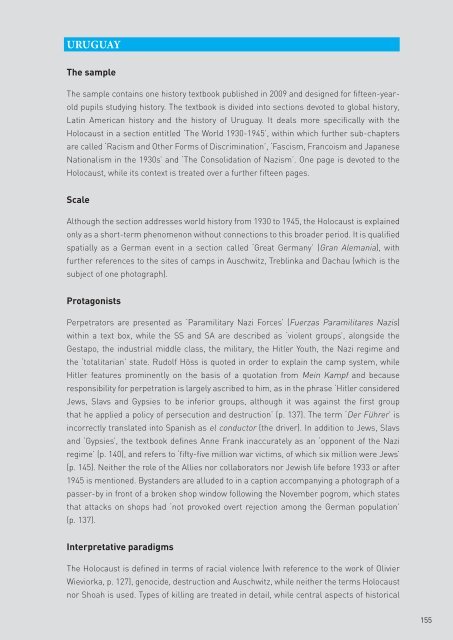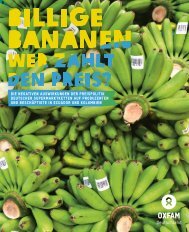228776e
228776e
228776e
You also want an ePaper? Increase the reach of your titles
YUMPU automatically turns print PDFs into web optimized ePapers that Google loves.
URUGUAY<br />
The sample<br />
The sample contains one history textbook published in 2009 and designed for fifteen-yearold<br />
pupils studying history. The textbook is divided into sections devoted to global history,<br />
Latin American history and the history of Uruguay. It deals more specifically with the<br />
Holocaust in a section entitled ‘The World 1930-1945’, within which further sub-chapters<br />
are called ‘Racism and Other Forms of Discrimination’, ‘Fascism, Francoism and Japanese<br />
Nationalism in the 1930s’ and ‘The Consolidation of Nazism’. One page is devoted to the<br />
Holocaust, while its context is treated over a further fifteen pages.<br />
Scale<br />
Although the section addresses world history from 1930 to 1945, the Holocaust is explained<br />
only as a short-term phenomenon without connections to this broader period. It is qualified<br />
spatially as a German event in a section called ‘Great Germany’ (Gran Alemania), with<br />
further references to the sites of camps in Auschwitz, Treblinka and Dachau (which is the<br />
subject of one photograph).<br />
Protagonists<br />
Perpetrators are presented as ‘Paramilitary Nazi Forces’ (Fuerzas Paramilitares Nazis)<br />
within a text box, while the SS and SA are described as ‘violent groups’, alongside the<br />
Gestapo, the industrial middle class, the military, the Hitler Youth, the Nazi regime and<br />
the ‘totalitarian’ state. Rudolf Höss is quoted in order to explain the camp system, while<br />
Hitler features prominently on the basis of a quotation from Mein Kampf and because<br />
responsibility for perpetration is largely ascribed to him, as in the phrase ‘Hitler considered<br />
Jews, Slavs and Gypsies to be inferior groups, although it was against the first group<br />
that he applied a policy of persecution and destruction’ (p. 137). The term ‘Der Führer’ is<br />
incorrectly translated into Spanish as el conductor (the driver). In addition to Jews, Slavs<br />
and ‘Gypsies’, the textbook defines Anne Frank inaccurately as an ‘opponent of the Nazi<br />
regime’ (p. 140), and refers to ‘fifty-five million war victims, of which six million were Jews’<br />
(p. 145). Neither the role of the Allies nor collaborators nor Jewish life before 1933 or after<br />
1945 is mentioned. Bystanders are alluded to in a caption accompanying a photograph of a<br />
passer-by in front of a broken shop window following the November pogrom, which states<br />
that attacks on shops had ‘not provoked overt rejection among the German population’<br />
(p. 137).<br />
Interpretative paradigms<br />
The Holocaust is defined in terms of racial violence (with reference to the work of Olivier<br />
Wieviorka, p. 127), genocide, destruction and Auschwitz, while neither the terms Holocaust<br />
nor Shoah is used. Types of killing are treated in detail, while central aspects of historical<br />
155




